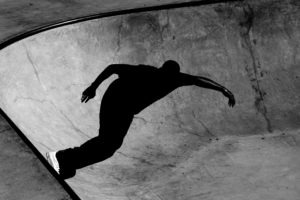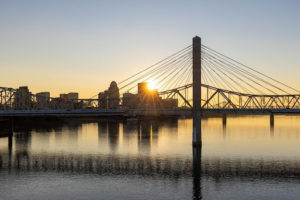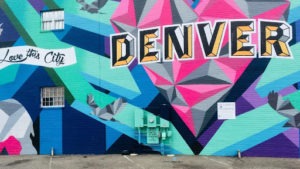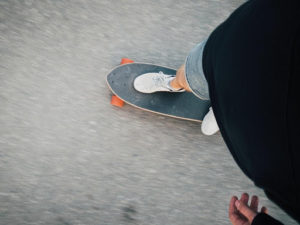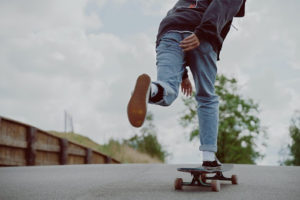Getting into a new hobby can be quite exciting, especially if it’s a hobby as thrilling as skateboarding. Regardless of if you’re entering the sport as a casual skater or you’re looking to dedicate some serious time to it, skateboarding offers a wide variety of benefits.
One of the most obvious benefits of skateboarding is taking part in physical activity. As skateboarding can be less monotonous than activities such as walking, running, or other sports, it can be a refreshing way to mix up your exercise routine and get outside. The unique nature of skating can promote improved coordination, reflexes, and stress relief. Skateboarding can also provide a sense of community with other skaters, helping you to make more friends!
When you’re new to the sport, the entirety of it can be a bit overwhelming. From perfecting your ride to choosing the right gear, there are a lot of things to take into consideration, including skateboarding lingo. When it comes to skating vocabulary and terms, there’s a lot to learn, and nobody wants to stand out as a newbie right off the bat. We’re here to help!
Check out our glossary of skateboard terms so you, too, can start talking like a pro.
Common Skateboarding Terms
Below we’ve included some of the skateboarding terms you’re most likely to encounter as you learn the culture, visit skate parks, and browse or buy products.
180
A half skateboard and body rotation performed front or backside. Think turning 180 degrees.
360
A complete skateboard and body rotation performed front or backside.
540
A one and a half skateboard and body rotation.
Aerial
A term for a trick in which all four wheels leave the ground. This can be done vertically or horizontally. Often shortened to “air.”
Airwalk
The skater grabs the nose of the board and kicks out their legs in opposite directions while in the air, appearing to walk in the air.
Alley-Oop
An aerial trick or ollie in which the skater moves their body sideways, in the opposite direction of the rotation.
Anchor grind
Grinding the board’s front truck onto a surface as the board’s tail points down and away from the same surface.
Axle
Axles are metal rods that connect the wheels to the skateboard deck. These components provide the board’s turning capabilities, allowing you to carve.
Backside
This term is generally used to describe any trick that is executed with the skater’s back facing the ramp or obstacle.
Bail
To jump, step away from, or otherwise abandon your board when it becomes clear that you won’t be able to safely land your trick, to try to attempt a painless landing instead. Very important for anyone looking to experiment with tricks. Think of it as your safety or backup plan.
Bank
A term for a slanted wall or surface that you can skate up and perform tricks on. Commonly used to do flat ground tricks.
Baseplate
The foundation of the truck. A solid metal plate with machine-drilled holes that is bolted to the bottom of the deck.
Bearings
Bearings are small round metal pieces that mount the wheels to the axle, enabling the wheels to turn. A skateboard requires two bearings for each wheel.
Boardslide
Using the middle of your board to slide down a rail or ledge. Parking blocks make great starting ledges for beginners. Practicing on a short surface can help you focus on balance rather than worrying about falling.
Bowl
Originally emptied out swimming pools, bowls are skateable areas with walls that wrap around 360 degrees, forming a bowl-shaped arena. Bowls are commonly found in many skate parks.
Brain Bucket
A term of endearment for a helmet, commonly used across several extreme sports such as snowboarding or skiing.
Carving
A fluid style of riding in which the skater makes a long, curving arc. Involves making big, fast, turns.
Complete
A fully assembled skateboard, equipped with all its components.
Deck
The common term for the wooden base of the skateboard that you stand on.
Drop in
A method of entering a bowl, halfpipe, or other skateable object from above. The skater moves from a flat platform to a steep transition.
Fakie
Performing a trick while riding backwards, with feet in normal stance and the tail of the board facing the intended direction. An important skill to master before attempting to ride vertical surfaces!
Frontside
Performing a trick while facing the ramp or obstacle.
Gnarly
One of the more popular terms among board sports enthusiasts. Often used to describe a trick that is impressive.
Goofy
A skating stance leading with the right foot on the deck, rather than the more common stance with the left foot leading, requiring the skater to push off with their left foot.
Grip tape
Sandpaper glued to the top of a skateboard deck to provide the traction and footing required for tricks. Grip taping can often be challenging for beginners.
Halfpipe
A U-shaped ramp with a flat bottom positioned between two vertical surfaces.
Kickflip
Manipulating the board with the feet during a jump or air trick. The board should complete a full rotation.
Land
To successfully execute a trick.
Longboard
A longer, often wider skateboard model. The longer and wider the board, the easier it usually is for beginners.
Nose
The term for the front of the skateboard.
Ollie
A jumping technique in which the skater lifts off into the air without the help of their hands or a takeoff ramp. Learn more about the history of the Ollie here.
Pump
A technique used to accelerate without the skater’s feet leaving the board. The skater drops into a crouch while crossing a flat surface and straightens their legs as the enter the sloped part of the ramp or bowl.
Quarter pipe
A wall with a curved base used to perform tricks. As the name might suggest, one quarter or side of a halfpipe.
Rail
The edge of the skateboard.
Regular-foot
The opposite of a goofy-footed stance. The skater leads with the left foot and pushes off with the right.
Risers / riser pads
Plastic pads inserted between the trucks and decks to adjust the height of the skateboard.
Session
Any time skaters get together and well, you know, skate. Often shortened to the term “sesh.”
Tail
The rear of the skateboard.
Transition
The curved part of a skating surface that is in between 0 and 90 degrees.
Trucks
The board’s front and rear axles. Trucks control the way you turn, ollie, and grind.
Wheels
The devices your board rolls on, usually constructed of polyurethane. Different wheels will provide different riding feels.
Wipe out
To fall off the skateboard.










